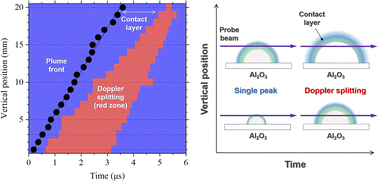Doppler splitting and expansion dynamics of laser-produced plasma plume under a high vacuum ambience†
Abstract
The expansion behaviour and spectroscopic characteristics of laser ablation plumes under a high vacuum ambience (<10−1 Pa) have not been investigated to date. For isotope identification using resonance ionisation mass spectrometry combined with laser ablation, a time-resolved spectroscopic investigation of the laser-produced plasma plume is necessary as the direction of atomic motions affects spectral features upon resonance ionisation due to multi-stage electron transitions. In this article, laser absorption spectroscopic measurements were conducted for the ablated plasma plume generated from an Al2O3 target using a nanosecond-pulsed laser. Our study mainly highlights that (i) Doppler splitting appeared after the plume front passed because of the formation of the contact layer and quasi-cavity in the plasma plume and the movement of atoms in the lateral direction at a high vacuum (3.0 × 10−4 Pa), and (ii) the loss of ejected atoms due to the laser-produced plasma expansion amounted to 43% at 3.0 × 10−4 Pa. Moreover, the two-dimensional contour figure that showed the Doppler splitting zone can be used to visualise atomic motions in the vertical and lateral directions, making it a useful tool for isotope analysis by resonance ionisation mass spectrometry.



 Please wait while we load your content...
Please wait while we load your content...